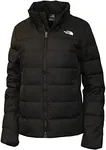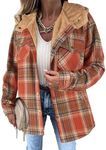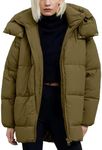Buying Guide for the Best Womens Winter Coats For Extreme Cold
Choosing the right women's winter coat for extreme cold is crucial to ensure you stay warm, comfortable, and stylish during the harsh winter months. When selecting a coat, it's important to consider various factors such as insulation, material, fit, and additional features that can enhance warmth and protection. Understanding these key specifications will help you make an informed decision and find the perfect coat to suit your needs and preferences.InsulationInsulation is what keeps you warm by trapping body heat. There are two main types of insulation: down and synthetic. Down insulation, made from the soft feathers of ducks or geese, is lightweight and highly effective at trapping heat, making it ideal for extremely cold conditions. However, it can lose its insulating properties when wet. Synthetic insulation, made from polyester fibers, is less expensive and retains warmth even when wet, but it is generally bulkier and heavier than down. Choose down insulation if you need maximum warmth and are not frequently exposed to wet conditions. Opt for synthetic insulation if you expect to encounter wet weather or need a more budget-friendly option.
MaterialThe outer material of a winter coat affects its durability, water resistance, and windproof capabilities. Common materials include nylon, polyester, and wool. Nylon and polyester are lightweight, durable, and often treated with water-resistant coatings, making them suitable for snowy or rainy conditions. Wool is naturally warm and breathable but can be heavier and less water-resistant. For extreme cold, look for coats with a durable water-repellent (DWR) finish to keep you dry and comfortable. Choose a material based on your typical winter weather conditions and your preference for weight and breathability.
Fit and LengthThe fit and length of a winter coat can impact both warmth and mobility. A well-fitted coat should allow for layering underneath without being too tight or restrictive. Coats come in various lengths, including hip-length, mid-thigh, and full-length. Hip-length coats offer more mobility and are suitable for active wear, while mid-thigh and full-length coats provide additional coverage and warmth, making them ideal for extremely cold conditions. Consider your daily activities and how much coverage you need when choosing the fit and length of your coat.
HoodA hood can provide extra warmth and protection from the elements, especially in windy or snowy conditions. Some hoods are insulated and have adjustable features, such as drawstrings or removable fur trim, to enhance warmth and fit. If you frequently face harsh weather, an insulated and adjustable hood can be a valuable feature. If you prefer a more streamlined look or plan to wear hats or other headgear, you might opt for a coat with a removable or stowable hood.
PocketsPockets are essential for keeping your hands warm and storing small items like gloves, keys, or a phone. Look for coats with fleece-lined pockets for added warmth and comfort. Some coats also have interior pockets for secure storage of valuables. Consider how many pockets you need and their placement to ensure they meet your practical needs and preferences.
Cuffs and HemCuffs and hems play a significant role in sealing out cold air and retaining warmth. Look for coats with adjustable cuffs, such as those with Velcro or elastic, to create a snug fit around your wrists. A drawcord hem can help seal out drafts and keep warmth in. These features are particularly important in extremely cold and windy conditions, as they prevent heat from escaping and cold air from entering.























